Today we shall look at the lowly ficus benjamina, a pariah of the bonsai world.
It seems that hardly anyone likes the so-called weeping fig except for rank beginners and…..wait a minute, am I reading this correctly?
I think I am….it seems that the really big time artists like Pedro Morales or Robert Stevens like them too.
Indeed.
Why?
What is it about these trees (and they are trees, I’ve seen them as big as freakin’ houses. So, to all you biased, ignorant, and elitist enthusiasts who dismiss benjaminas, and any ficus for that matter, to hell with you!) that inspire those enthusiasts who are just beginning their bonsai journey and those masters who should know better?
Well, that’s what I’m here to try to explain.
And, as always, I have a tree to work on at the same time.
I’ll begin by listing the drawbacks, which are many, to the cultivation and styling of this kind of tree.
Today’s work will be on a smaller leafed variety of ficus benjamina called “too little”.
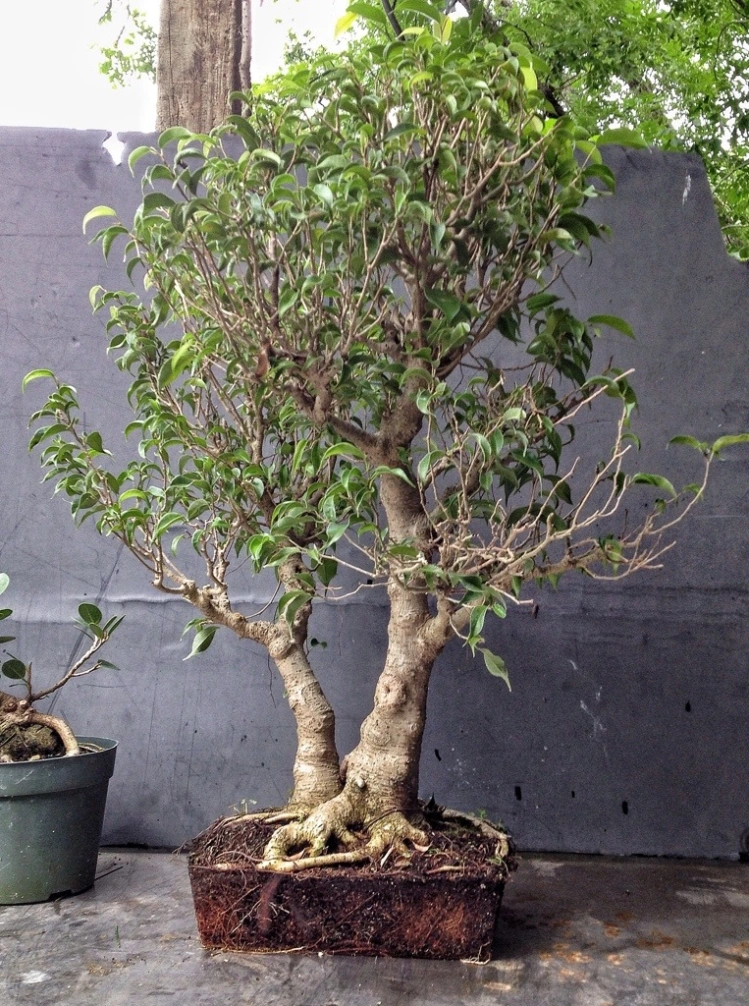
A medium or “chuhin” sized tree.
It’s been neglected a little and it’s rootbound.

Which isn’t too much of a problem with ficus.
This is the pot it’s been residing in for a few years.
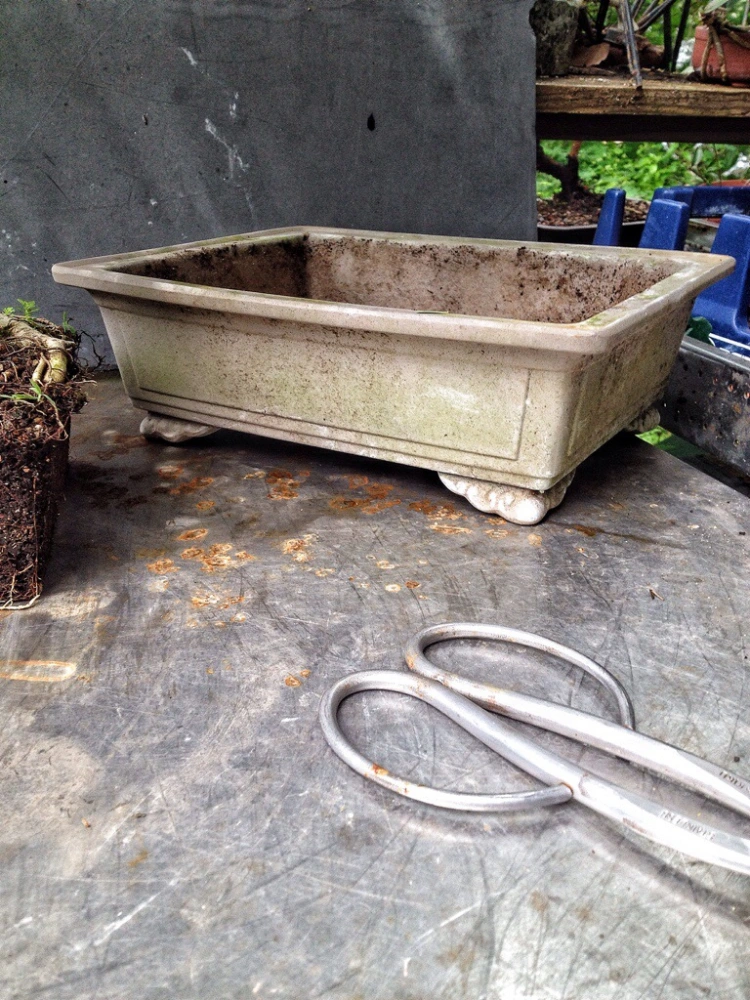
I’m going to go through the negative characteristics and, as I describe them, I’ll put them all into perspective.
One complaint against the benjamina is that you’ll get interior dieback like this.
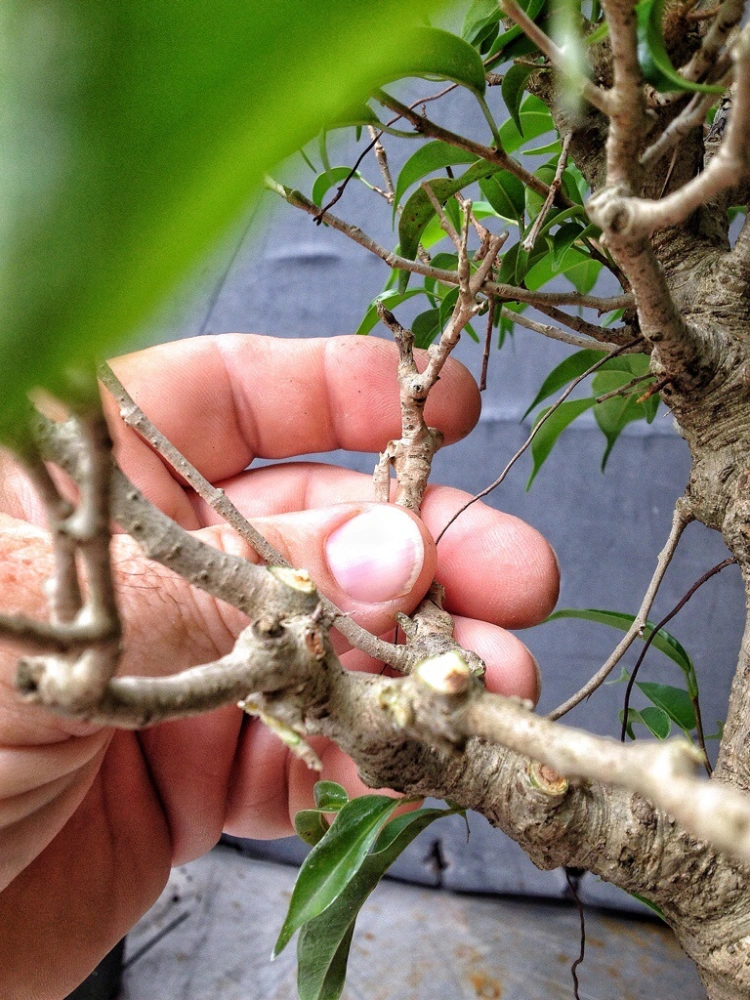

The reason it does this is an easy one. Lack of light.
The same thing happens on junipers too.
Solution: keep them trimmed.
The next complaint: bizarre back budding.
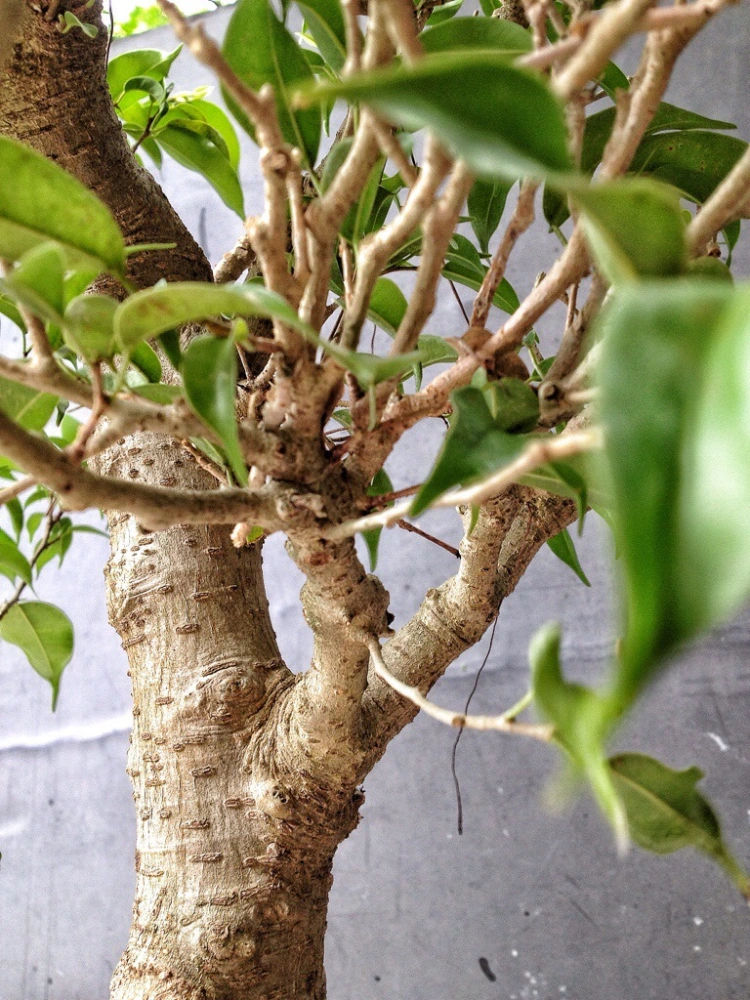
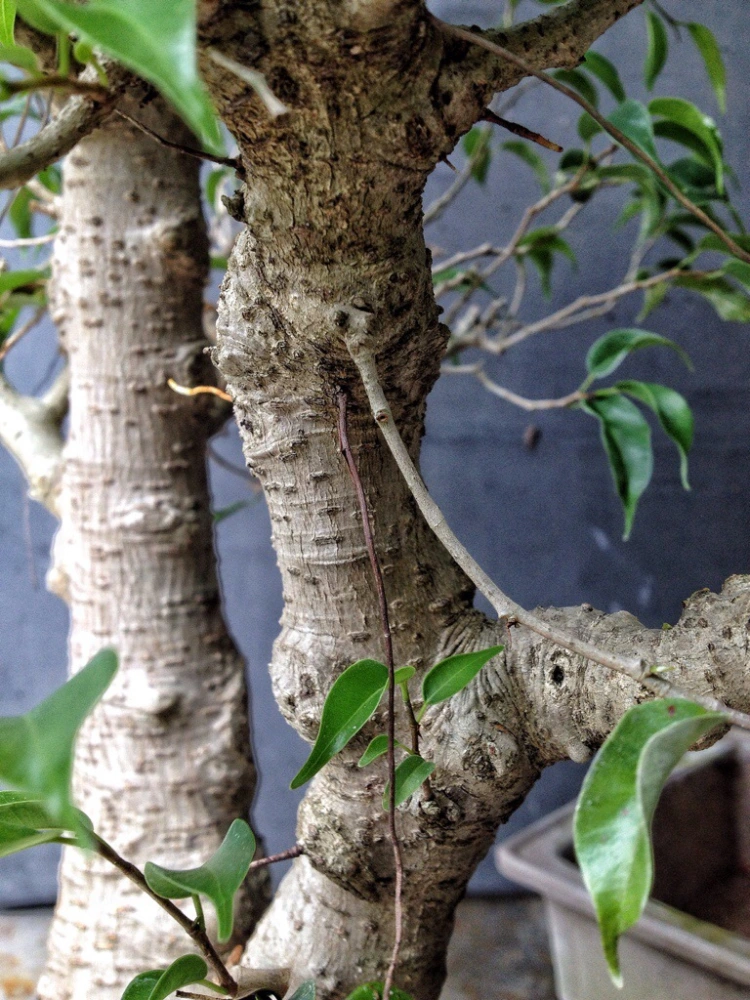
I’m not sure why people complain about this but they do.
My rebuttal: have you ever worked on a trident maple?
They do the same thing and the trident is considered one of the best trees for bonsai.
Let me begin pruning the tree I have in front of me and as I cut, I’ll deal with the first two criticisms.

Looks intimidating, doesn’t it?
Oh, here’s a third one too: the branches will suddenly grow straight up from a top bud.
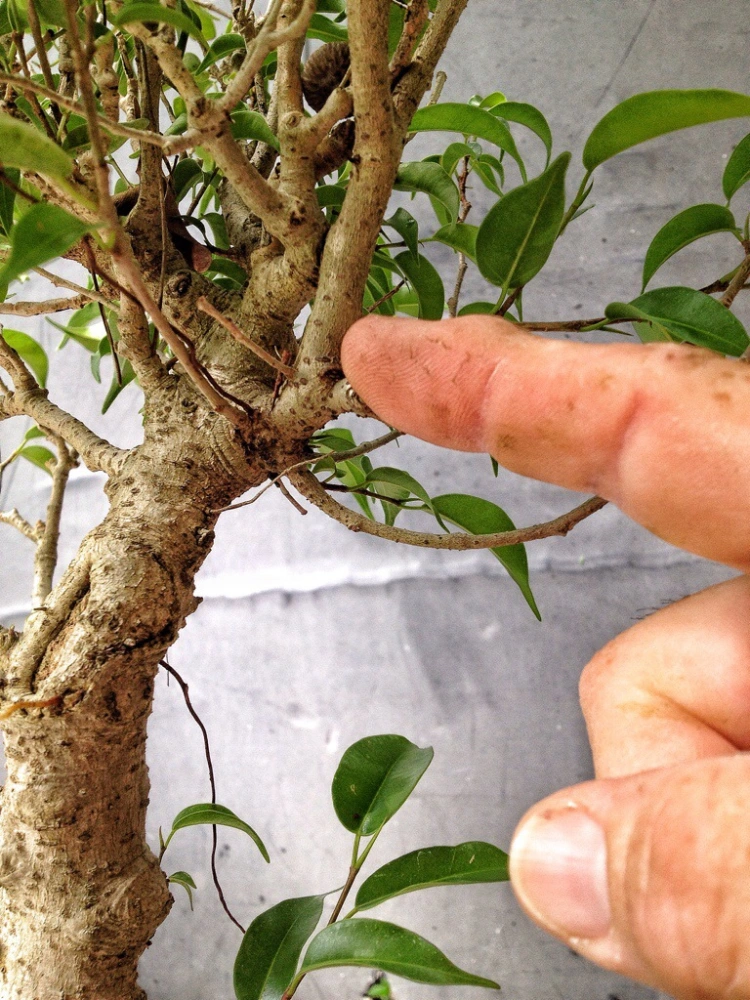
An annoying growth habit.
One shared by most elm trees.
How do you deal with it?
Easy, and it’s even a cliche, nip it in the bud.
Or, if you discover it too late….
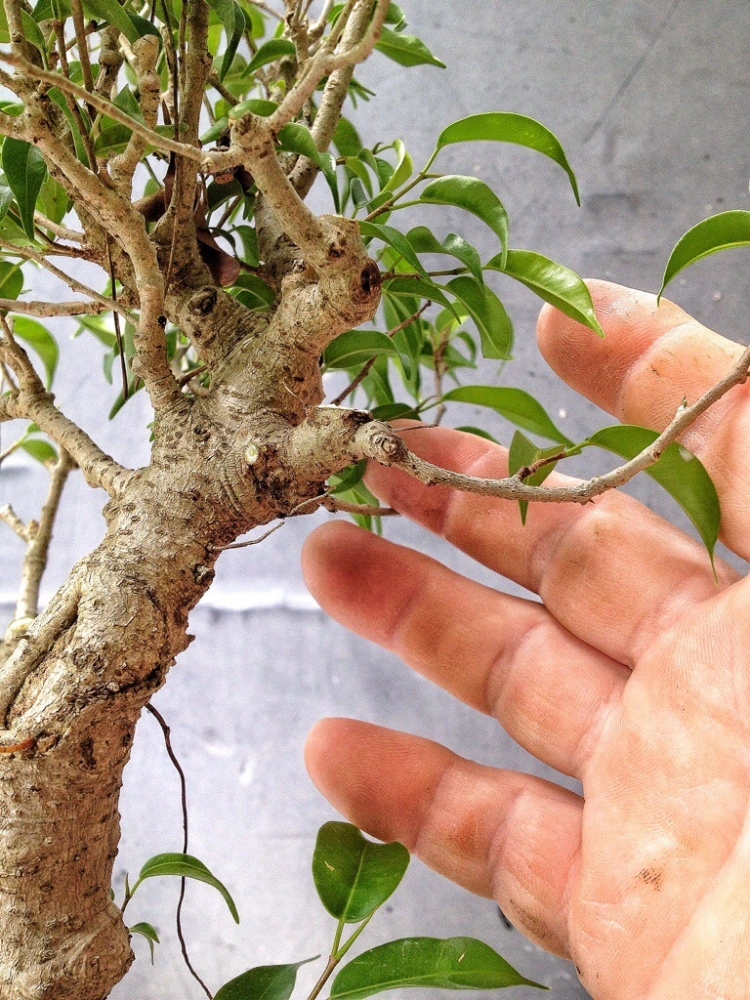
…..nip it at the base I guess.
Ok…all the dead branches, odd shoots, multiple limbs et al, have been removed…..
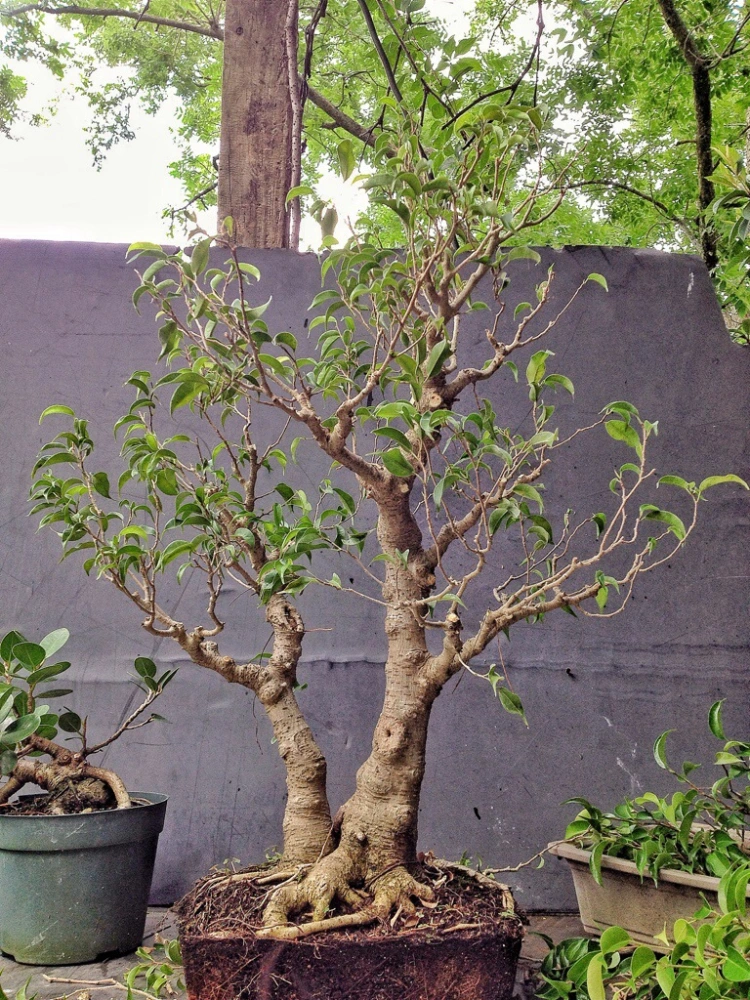
….and this leads us quite nicely to the number one complaint about the ficus benjamina: if you cut a branch and don’t leave green, (a leaf or a visible bud) that whole branch will die.
To answer this pet peeve let me remind everyone that both junipers and pine trees are exactly the same as the ficus benjamina in this characteristic. And they are considered the two best trees for bonsai (at least by most bonsai people).
Why is this dieback characteristic vilified in the weeping fig but treated as a thing to be endured on a conifer?
Hmmmmnn…
How do we then prune this ficus if we could inadvertently kill a branch with an errant snip of our scissors?
Like this:

Which is the same way one prunes a conifer; leave some green.
In order to encourage some back budding, I’m going to prune as far back as I can.

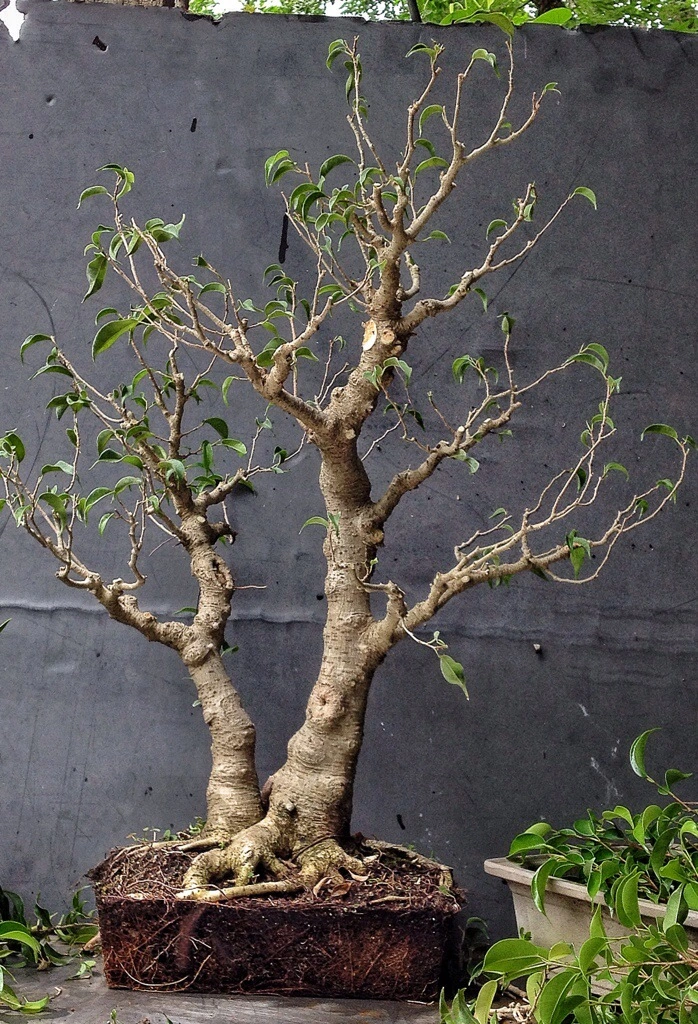
And contrary to popular belief, you can defoliate a benjamina. You just have to make sure that you don’t damage the visible bud under the leaf.
Why would you need to defoliate one?
If you were showing the tree and you needed smaller leaves you would defoliate it.
The tree (most trees, actually) will respond by putting out twice as many leaves but they’ll only grow half as big.
This technique takes advantage of the way trees feed themselves.
The process is called photosynthesis. And, basically, a tree needs a certain square footage (or, in the rest of the world using the metric system, square centimeters, which just doesn’t sound as lyrical or poetic) of leaves to accomplish this process. When the leaves are damaged due to wind or insects (or my pruning shears) the tree responds by ramping up leaf production and growing as many as it can. But they’ll stop growing once that square footage is reached.
And they’ll have smaller leaves as a result.
I will point out this: we only do it to trees that are healthy and in development (for show or ramification).
A seedling doesn’t need this technique.
I won’t be defoliating today (Wow Adam, are you ok?) because I don’t need smaller leaves.
They’re “too little” now anyway (groan, I know, I know, I had to say it though).
Some other negative things that people don’t like have to do with wiring.
First, they say that wired branches don’t stay in place when you take the wire off.
Try working with a white pine.
Next, the branches get wire scars too easily.
Hornbeam?
Japanese maple?
Anyone?
And lastly, the branch will die if you wire it.
Ginkgo biloba comes to mind.
So, my dear readers, what are some of the positives about this ficus and do they make up for the (supposed) negatives?
Let’s see if I can make a case.
I’ll start at the roots.
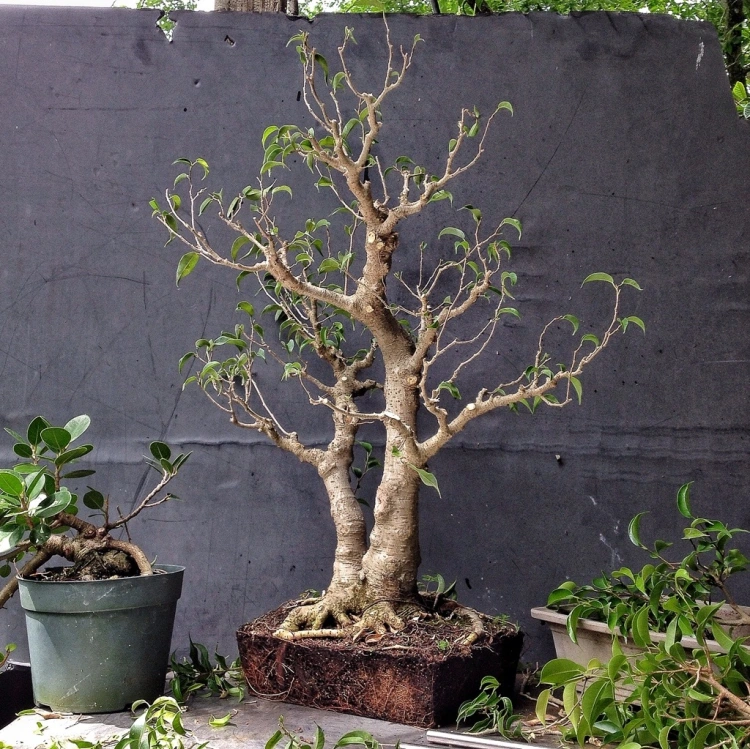
Being a ficus, you can cut the shit out of the roots and it won’t skip a beat just as long as it’s growing (which is year long if you can give bottom heat to the root zone). And, FYI, “cut the shit” is a highly technical horticultural term we in the industry use when we mean ” prune aggressively”.
Just in case you want to sound like you are “in the know”.
On my victim today, I don’t need to be all that drastic with the root work.
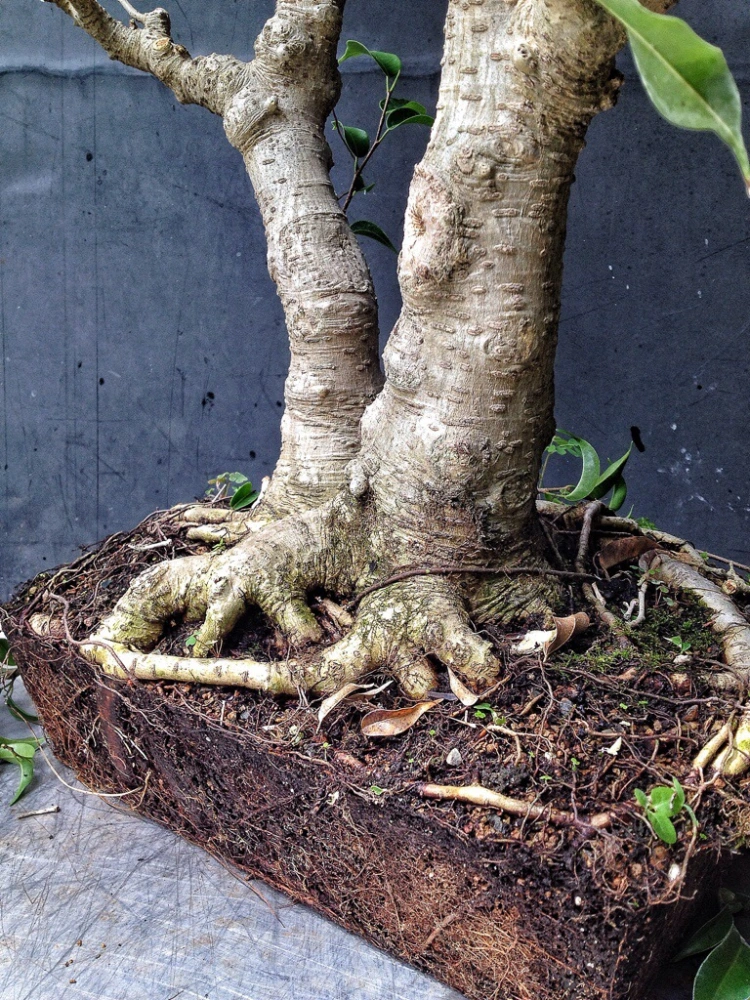
There’s just one root I need to cut out.
Do you see it?
Yeah?
Now you don’t!
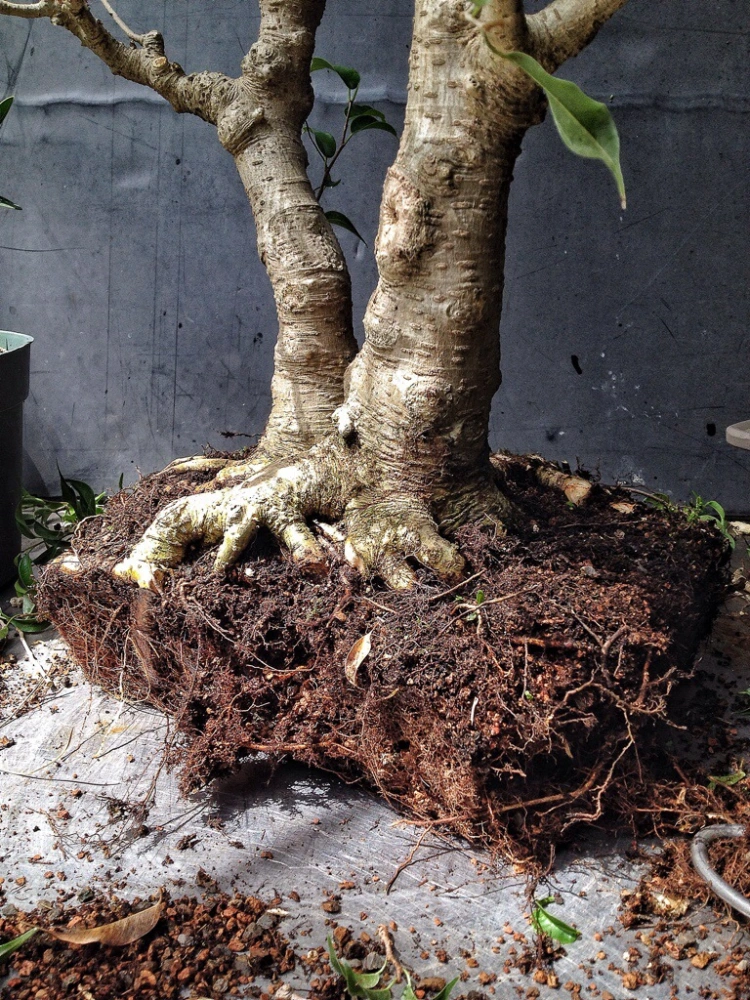
If you’ve read my posts before, you’ll know that I truly dislike crossing roots on a ficus.
How then can I abide this?
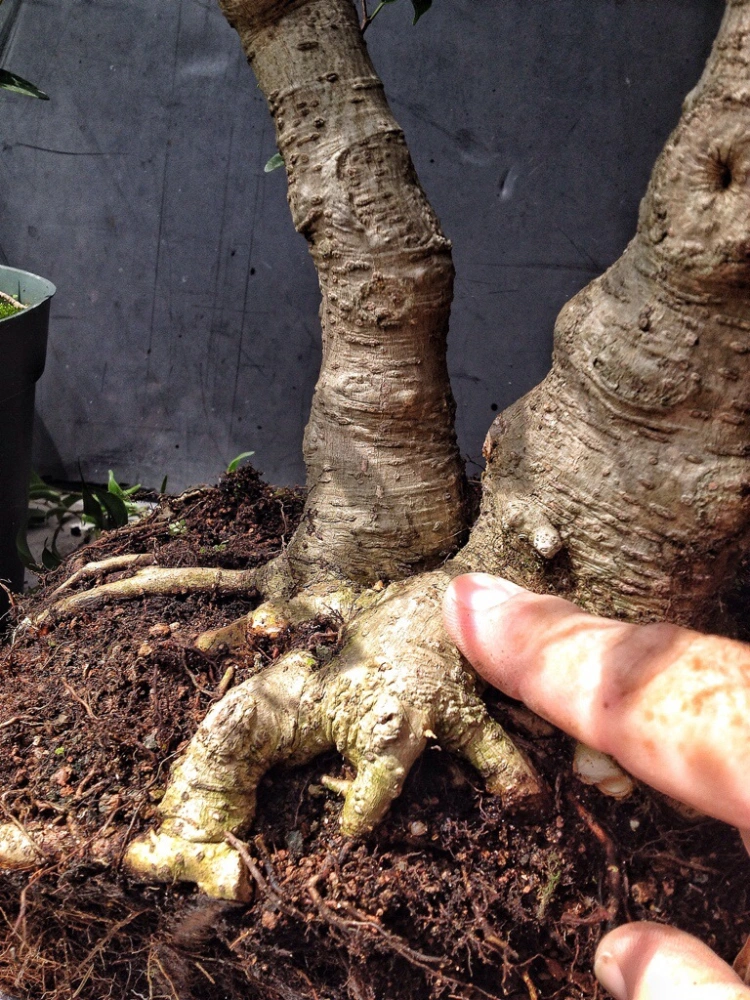
Well….let me introduce you to a twin trunk style called, variously, “mother/daughter”, “father/son” or “husband/wife”.
This one is a husband/wife; I’ll explain why in a second.
A father/son composition usually has one large and one half size tree and the smaller tree is in front.
A mother/daughter is a larger and a 1/3 size with the smaller tree in the back.
A husband/wife is two trees that are close to being the same size, maybe the smaller one is 3/4 as large.
The wife should be behind the husband.
And, as you might have guessed already, the placement is as it is for purely male chauvinistic reasons.
The male protects the female.
The father pushes his son forward.
The mother protects the daughter.
One more detail.
You may have noticed that I rotated the front from here:

To here:

This was to bring the couple closer together with the wife leaning towards the husband, adoringly worshiping her man.
Like I said, chauvinist through and through.
And that’s how I justify this crossing root.
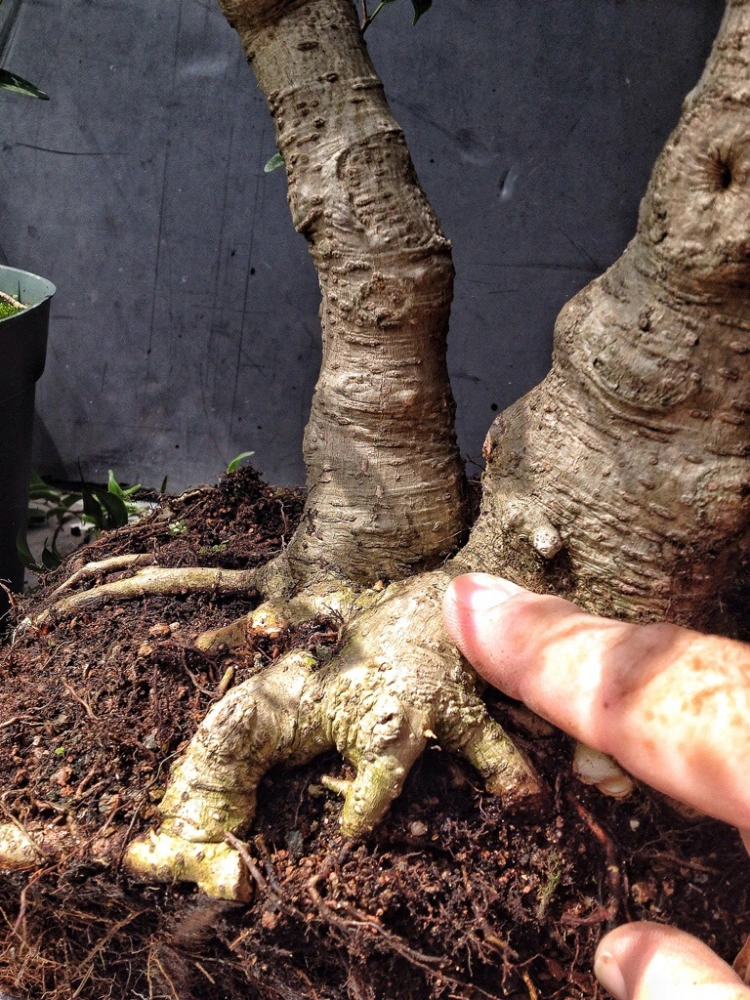
The husband is protecting his wife, or making sure she is behind him.
It’s a touchy subject.
But it segways right into another positive feature about the benjamina.
Of all the ficus (or trees in general) I’ve worked on, the benjamina will develop better nebari faster than any other.
The tree throws out roots readily (both surface and, if you want them, aerial) and from all sides (radially,as it were), which is what a bonsai artist is looking for in a tree.
They even fuse faster than any other tree, making for that melted wax look that’s prized on a root spread.
And, with our couple, as with all couples, the roots will fuse and become as one.
Also, as an aside, they propagate from cuttings very easily, with almost all cuttings developing roots fast.
Speaking of well developed roots, back to the work at hand.
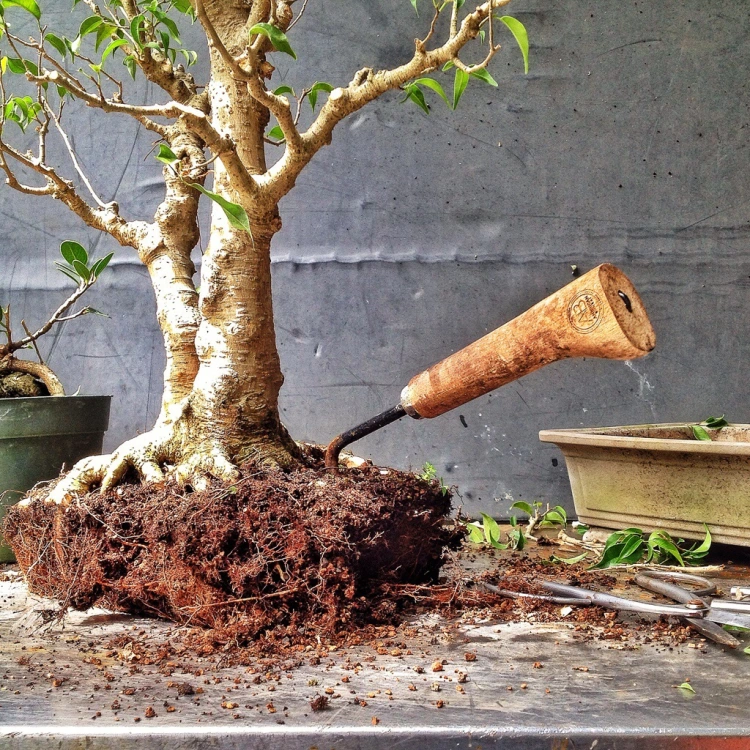
A fair bit or raking and pruning later.

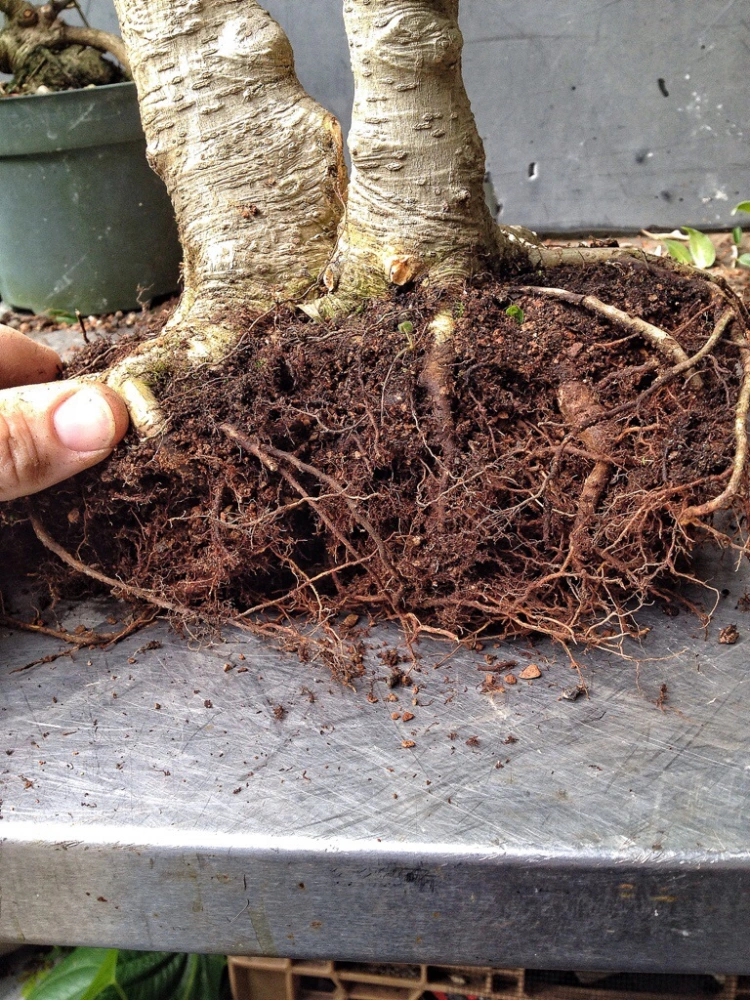
A fresh bed of my Supermix™.
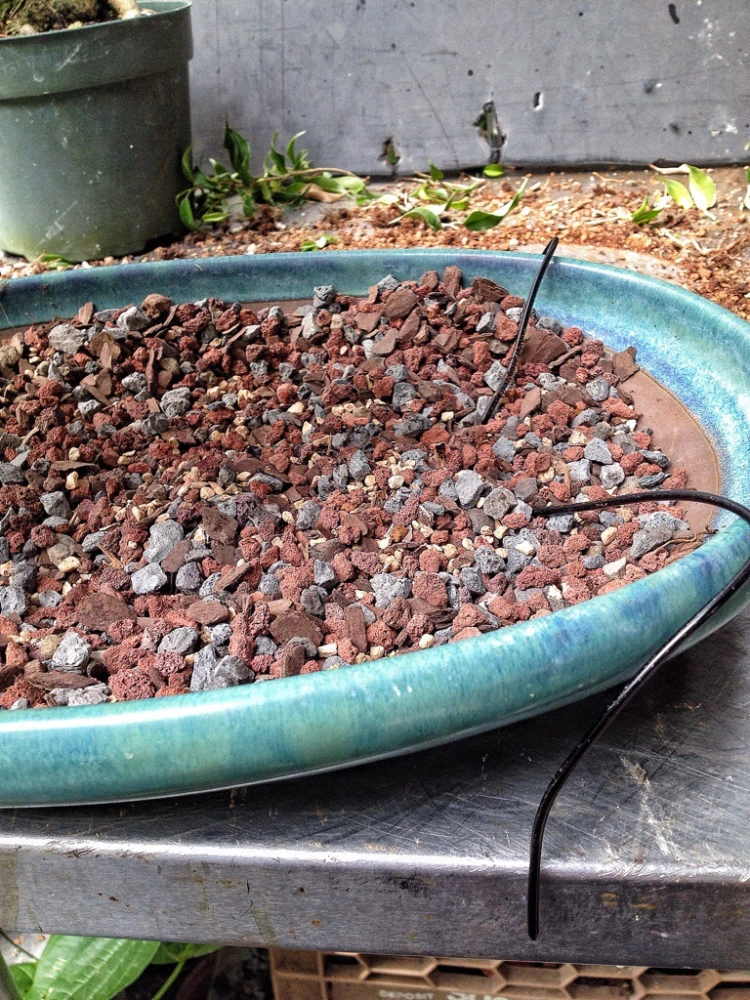
And Bob’s your uncle.
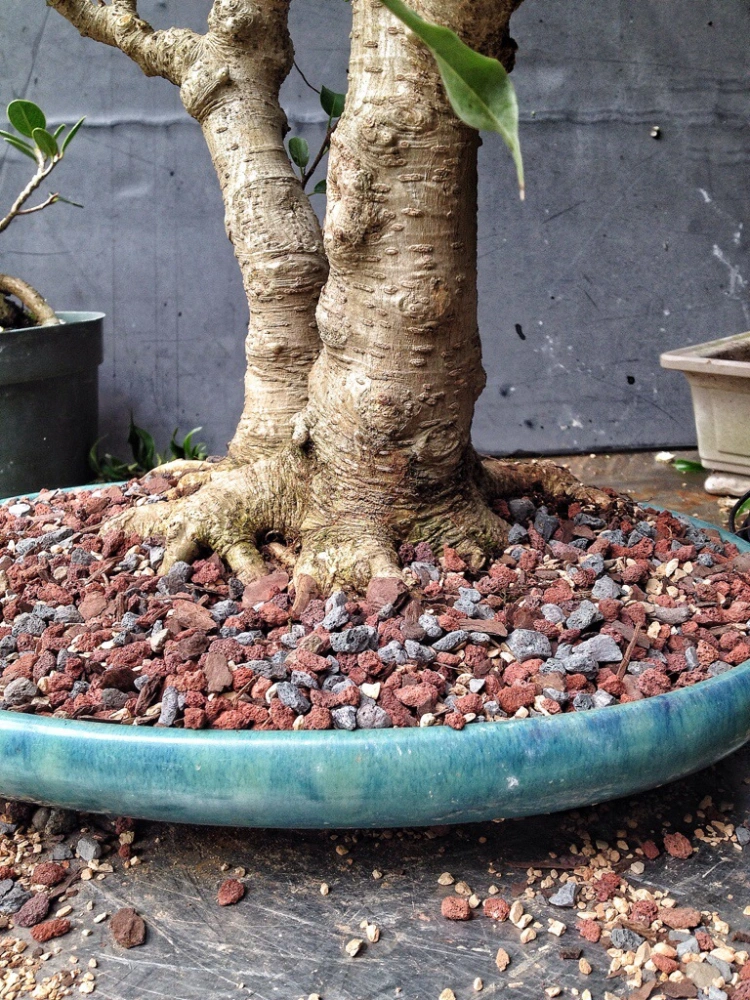
Actually, Bob is my neighbor. Really nice man, he grows his own food and shares it with my large family all the time.
My wife loves it when it’s collard green time. I cook them with a ham bone and I use beef stock and I add lots and lots of garlic and onions.
Yum!
As for the ficus, plenty of organic fertilizer.
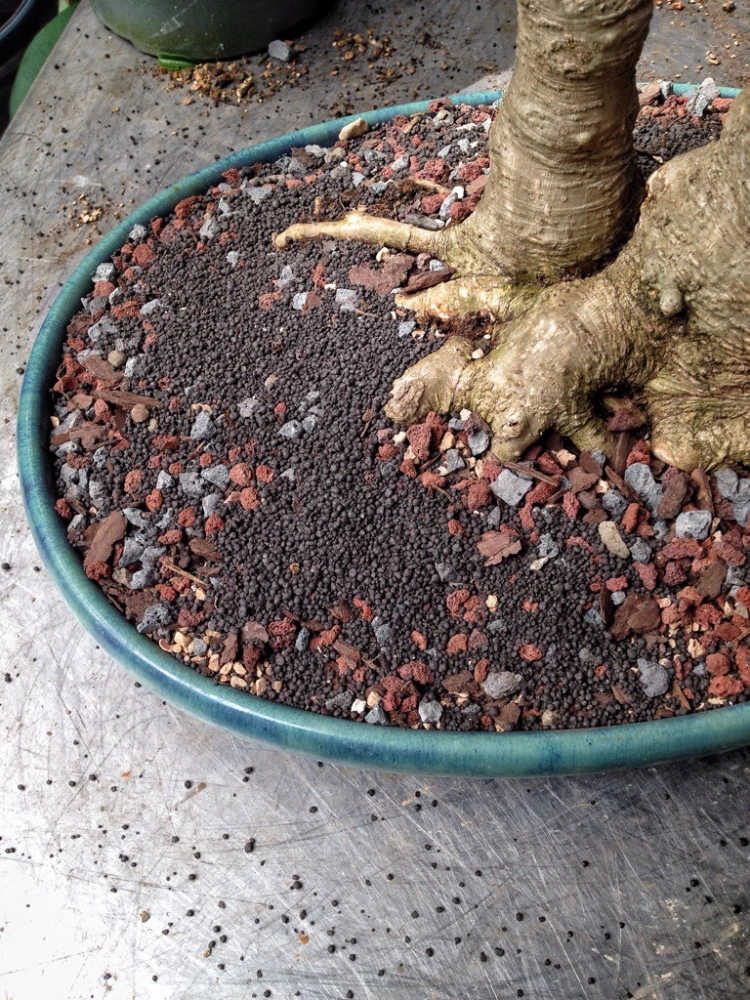
Yes, that much.
And a pre-emergent weed preventer.
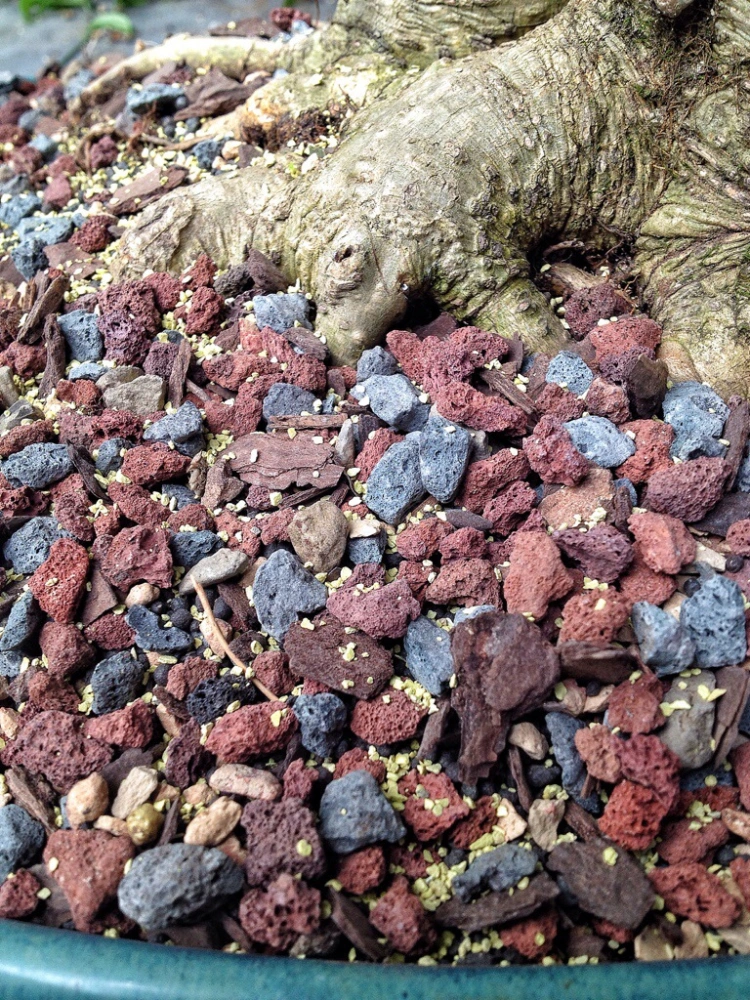
And I think I’m done.
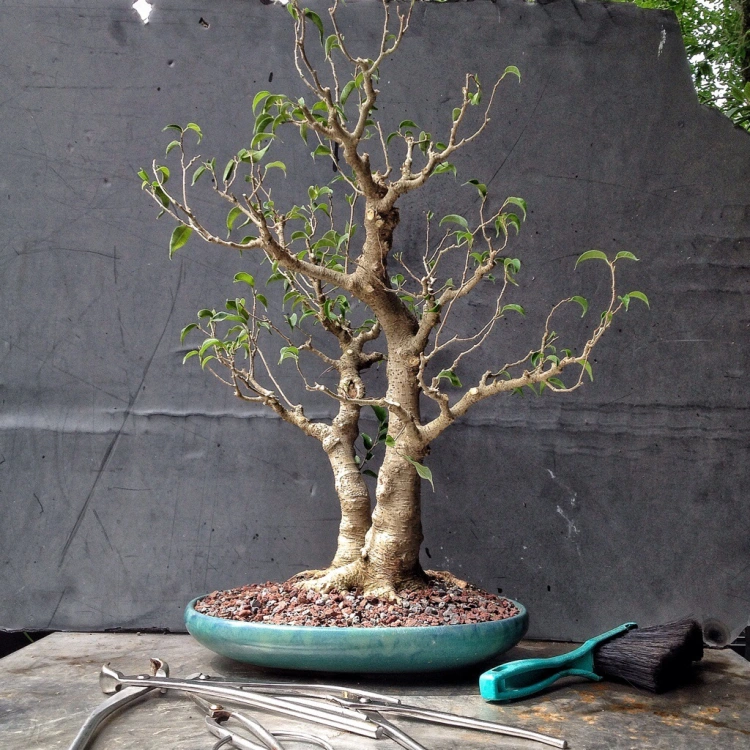
No, not quite.
This branch has to go, it’s crossing and breaking up the trunk lines.
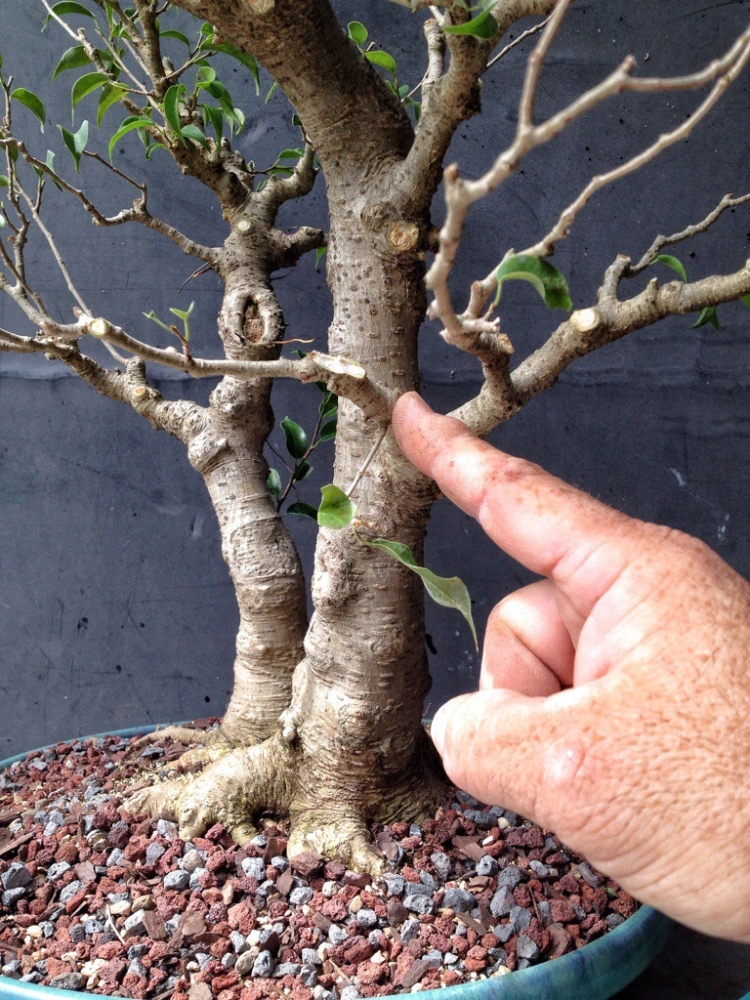
Which leads us to one final pro in the benjaminas favor.
If I cut this branch, I’ll have a big pruning wound right in front for everyone to see (which I don’t mind too much, but some people think it’s an affront to god).
The benjamina heals faster than any tree I’ve seen too, ficus or not.
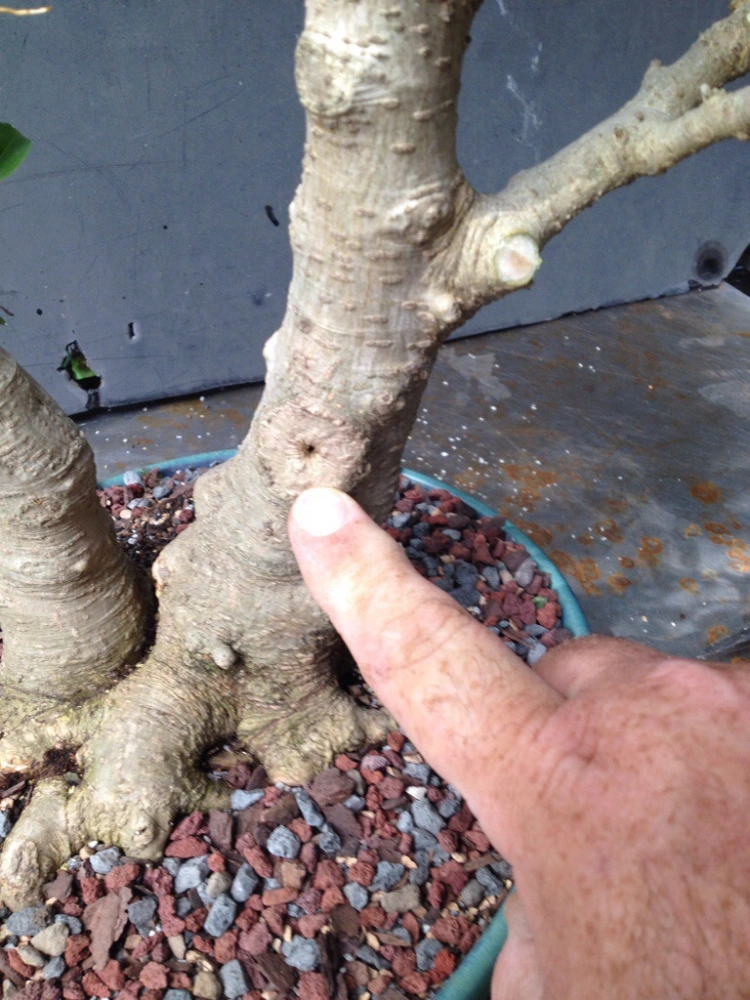
So I’m not worried about this cut.
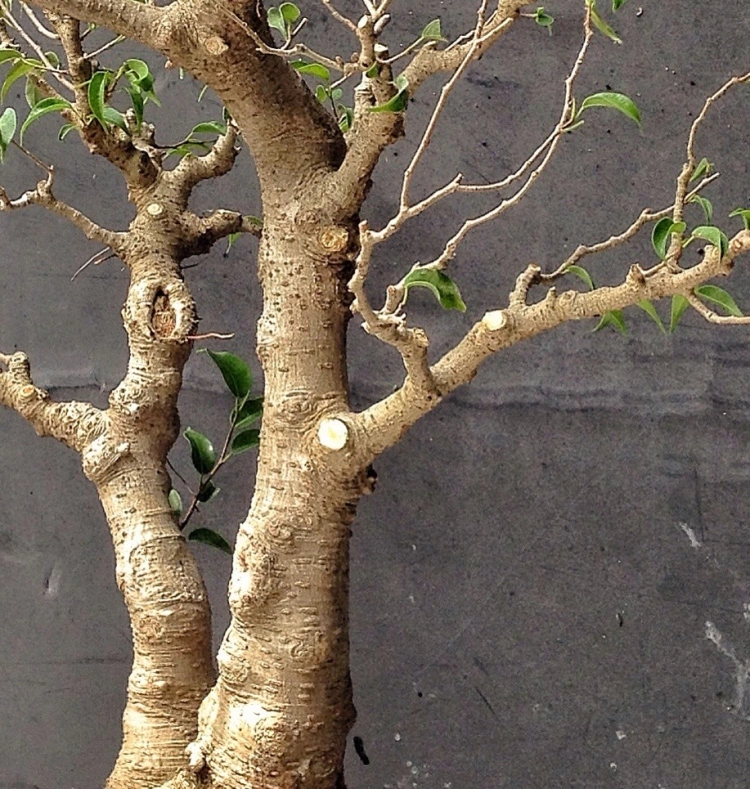
Or the one behind it either.
One last bit of housekeeping and then I’m done.
The benjamina is loved by one other creature that I must mention.
The Cuban laurel thrip.
I control an infestation (which is evidenced by the leaves folding in half longways) by using this product.
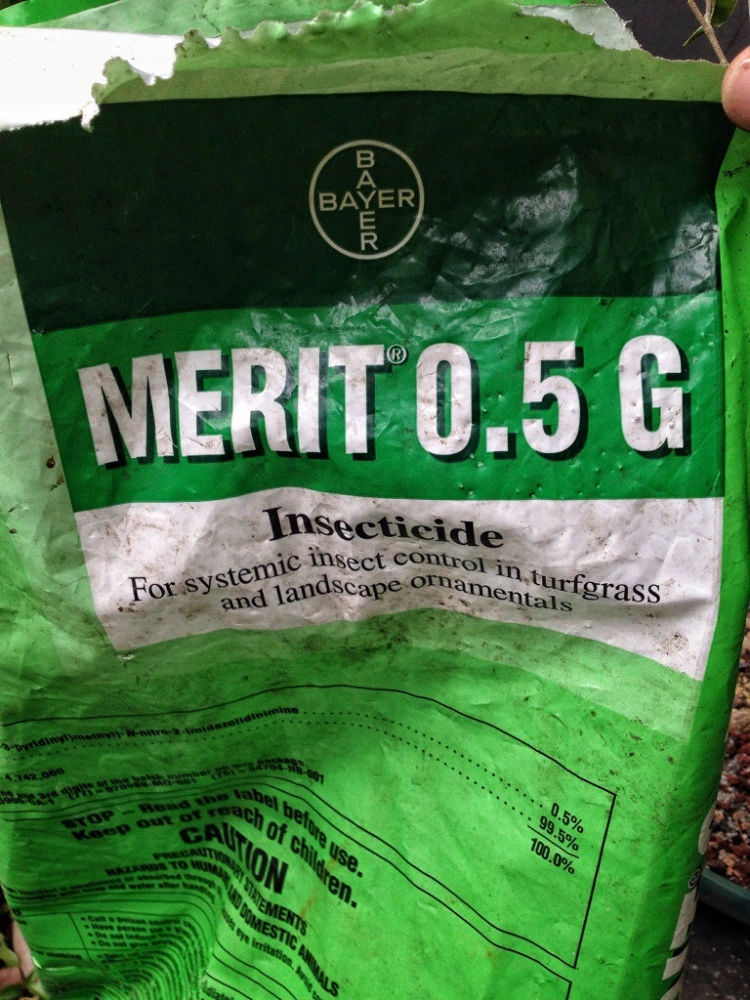
It’s a granular systemic that works by making the plant poisonous to the bug if the bug chews on the plant.
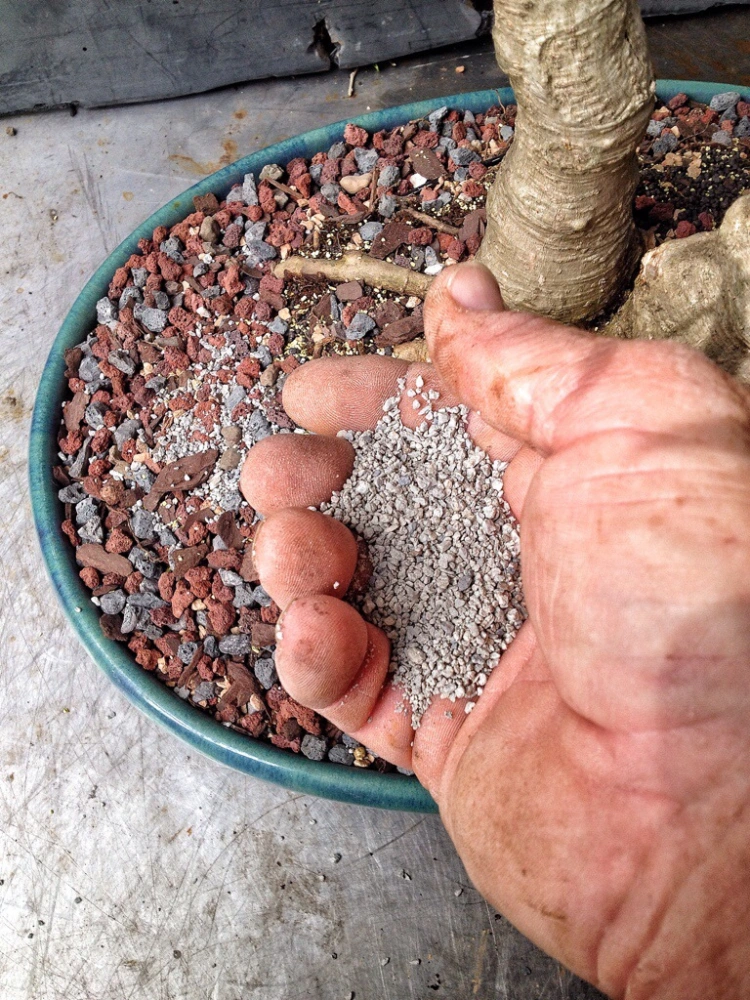
It’s safer to use than a spray (no accidental inhalation or overspray) and it is targeted to one specific plant.
And with that done, I’m done.
I think, dear reader, the evidence is clear that a benjamina can (and does) make good bonsai.
Of course there are those that will never be convinced; these are the enthusiasts who’ve made a good intermediate level career by sneering at those hapless fools who just won’t listen to their good advice (“Why, oh why can’t the noobs just trust all my years of accumulated knowledge? It’ll save them so much time and wasted work on those worthless trees.”)
Here’s the before.

And here’s the after.
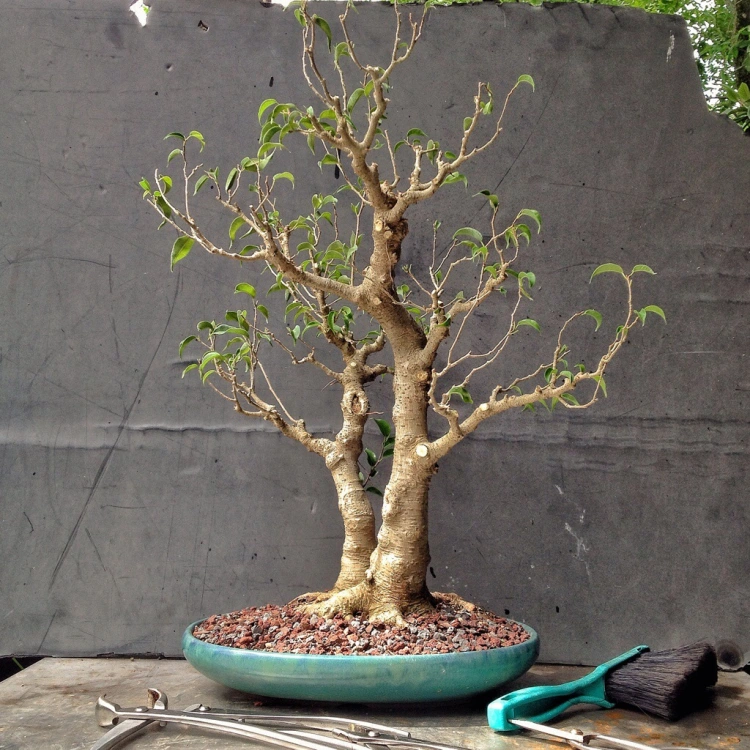
Looks like a tree to me.
A bonsai tree, even.
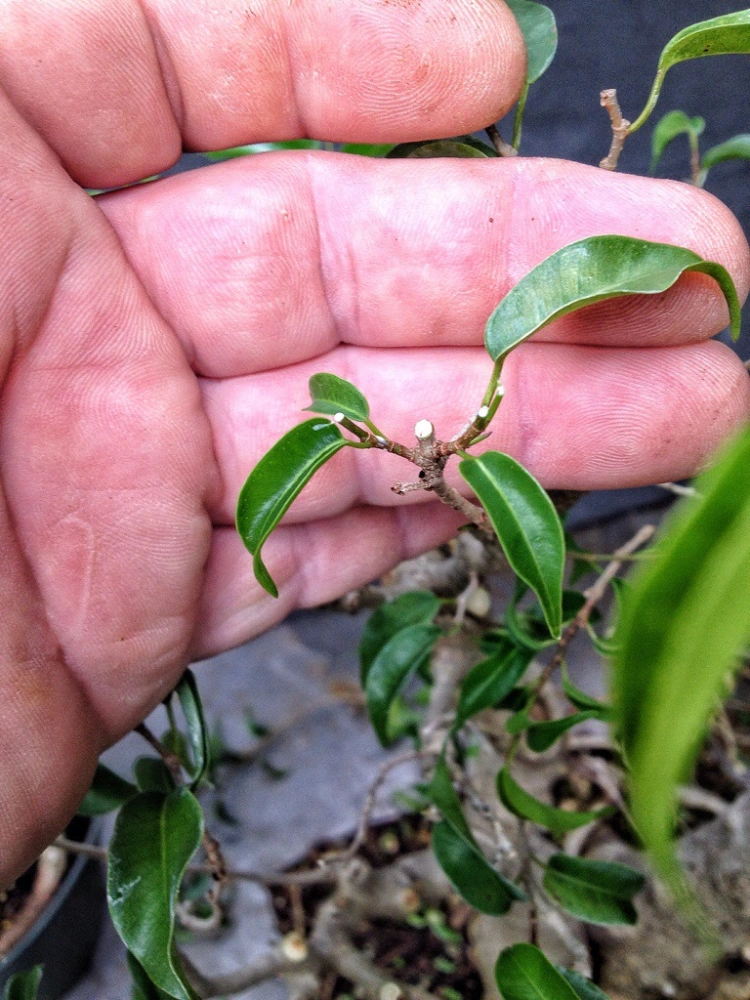
What’s your Supermix comprised of?
LikeLike
It is one part each of : red lava, calcined clay, sifted pine bark, expanded shale, and expanded slate. Maybe a little more lava sometimes
LikeLike
What are the benefits of the shale and slate? The mix I have been using is the same as yours, but w/o those two ingredients.
LikeLike
They add a different shape, which gives me lass compaction and more stable air spaces and they don’t hold too much water (only about 10-20%).
I’m in Florida where it can rain every day, 2-4 inches at a pop and the trees can become waterlogged unless I use a very free draining mix.
LikeLiked by 1 person
Excellent and, as usual, funny.
LikeLike
Put me on the list of ficus benja lovers-I’m south of you-the thrips will make the plant look bad, but the white fly will kill it-systemics are really needed (I use a Bayer product) and they work well.
LikeLike
What a great read Adam.Im convinced if nobody else is, lol.I love ficus period.Adam what do you think about ficus growing situation in memphis? Will they thrive not thrive will they just be ok? What’s your thoughts if you have the time? Thanks for a wonderful read as usuall, and the awesome guy you had me get in touch with about your cypress class is amazing and taking care of me, what a nice guy.Later.
LikeLike
Great article Adam. Perhaps worth re-publishing in my Potomac Bonsai Association newsletter? with your permission of course? 🙂
LikeLike
Thanks Sean, feel free to republish. I’m honored.
LikeLike
Adam your blog is very cool!! I’m from Brazil, so we like ficus benjamina here! yes, they are huge as a freakin house!! bring it on in the posts!!
LikeLike
Hi!
Awesome tree! Can you point me in the direction of some good reading on Benjaminas? Recently acquired a 7 feet potted tree that I want to chop. Do Benjaminas respond well trunk chops?
I must say i love your blog and your work, you’ve completely changed the way I view bonsai.
Keep on trucking!!
//erik
LikeLike
It’s tough to chop them. Sometimes they die to the base. My best advice is to cut about 6 inches higher than you think and hope for the best. And seal the chop.
The peoples who use them most are tropical artists in Puerto Rico, India and Indonesia. Look into their writings.
LikeLike
Yeah I’ve read the same thing about the trunk chop. But I’ll do as you suggest and chop it well high. Both the trunks have some low growth so I’ll put my hope in that.
Thanks for your help!
LikeLike
If they have low growth you shouldn’t have a problem. Good luck!
LikeLike
Cool, feeling a bit better about it!
Ignore the double comments. I suck at wordpressing.
Thanks again!
LikeLike
Yeah I’ve read the same thing about the trunk chop. I’ll do as you suggest and chop it well high. Both trunks have got some low growth so I’ll put my hopes on that.
Thanks for your thoughts.
LikeLike
Reblogged this on Bonsai advice and commented:
Nice benjamina advice
LikeLike
Adam,
Will that granular insecticide work on most species used in bonsai? Any species it should not be used on? And also, what granular organic fertilizer were you using there?
Thanks,
Rick
LikeLike
It works on most plants. Don’t use on fruiting specimens where you might eat the fruit.
I use Milorganite fertilizer.
LikeLike
Just came across this article – wonderful job on the ficus. It’s been two years – do you have a current picture?
Sheila
LikeLike
I don’t have a current pic, I sold it. If you go on my Instagram (adamaskwhy) you’ll find in the October 2014 area
LikeLike
I’m loving this post! Renewed my interest in the benjamina which is great, since they seem to be some of the most available ficus material around. Now why people plant them as hedges just so they can rotate away? This is will never know. So many better species they could use. Guess it’s the fast growth.
LikeLike
Thanks for the post. I am a benjamina fan, I have trees from over 50yo down to recent cuttings and they never fail to delight. As for the criticism, most negatives can be solved if the grower pays attention to the needs of the tree and follows Adams advice. I have individual trees and group plantings. One group planting recently won ‘best in show’ against some stiff competition. I encourage all bonsai enthusiasts to give the benjamin’s a go. You will not be disappointed.
LikeLike
Benjamina look great in forest plantings too. Wiring defo does not work, but you can be sneaky and cut a wedge at the axis of an upward growing branch, bend the branch down and keep in place with a wire loop under the pot. The effect is that a canopy forms easily as the extra light encourages back budding. Look at the left of the tree here to see the result:
A Norwegian lass bought this as a tiny pot plant in Ikea 15 years ago. She went back to Norway so I adopted it.
LikeLiked by 1 person
Just picked up this very tree! What are the odds! Even more excited to get it after reading this article! I read it several times! Wonderful stuff here! Thank you!
LikeLike
That’s cool to find out where a tree has journeyed. Where do you live?
LikeLike
Northern Virginia. I purchased it yesterday. I immediately started checking out articles online and of course yours caught my eye for obvious reasons. It’s clearly a beautiful tree that I’m thankful to have and care for. Only been into Bonsai for a few years and mostly have portulacarias, nerifolias and bougainvilleas. Your article was really enjoyable to read! So, thank you!!
LikeLike
You’re welcome. I’d love to see a pic of it if you’d care to send it. My email is Adamaskwhy@att.net
LikeLike
Absolutely will! I expect to receive it tomorrow (according to FedEx). Once unpacked I’ll snap a photo and will send it your way!
Justin
LikeLike
Looks great to me! I’ve almost survived my 1st year as a gardener and I have grown quite fond of my ficuses. I’m looking to start my first bonsai and I do believe that a variegated benjamina will be quite the fun project! Since I am confident that all of my ficuses love me, this just seems like a logical next step. Thanks for sharing 🙂
LikeLiked by 1 person